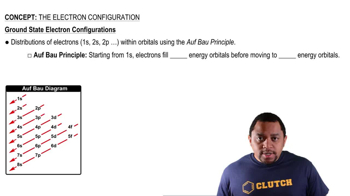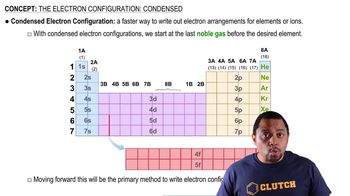Identify the specific element that corresponds to each of the following electron configurations and indicate the number of unpaired electrons for each: (d) 3Kr45s24d105p4.
The following electron configurations represent excited states. Identify the element and write its ground-state condensed electron configuration. (b) 3Ne43s13p44p1.
 Verified step by step guidance
Verified step by step guidance
Verified video answer for a similar problem:
Key Concepts
Electron Configuration

Excited State vs. Ground State

Condensed Electron Configuration

(a) What does the term paramagnetism mean? (b) How can one determine experimentally whether a substance is paramagnetic? (c) Which of the following ions would you expect to be paramagnetic: O2+ , N22 -, Li2+ , O22 - ? For those ions that are paramagnetic, determine the number of unpaired electrons.
The following do not represent valid ground-state electron configurations for an atom either because they violate the Pauli exclusion principle or because orbitals are not filled in order of increasing energy. Indicate which of these two principles is violated in each example. (a) [Ne]3s23p63d5 (b) [Xe]6s3 (c) 1s23s1.
Consider the two waves shown here, which we will consider to represent two electromagnetic radiations: (a) What is the wavelength of wave A?
Consider the two waves shown here, which we will consider to represent two electromagnetic radiations: (b) What is the frequency of wave A?
If a sample of calcium chloride is introduced into a nonluminous flame, the color of the flame turns to orange ('flame test'). The light is emitted because calcium atoms become excited; their return to the ground state results in light emission. (b) What is the energy of 1.00 mol of these photons (a mole of photons is called an Einstein)?
